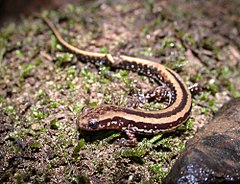Eurycea
Eurycea – rodzaj płazów ogoniastych z podrodziny Hemidactyliinae w rodzinie bezpłucnikowatych (Plethodontidae).
| Eurycea[1] | |||||
| Rafinesque, 1822[2] | |||||
 Przedstawiciel rodzaju – żółcik trójpasy (E. guttolineata) | |||||
| Systematyka | |||||
| Domena | |||||
|---|---|---|---|---|---|
| Królestwo | |||||
| Typ | |||||
| Podtyp | |||||
| Gromada | |||||
| Rząd | |||||
| Rodzina | |||||
| Podrodzina | |||||
| Rodzaj |
Eurycea | ||||
| Typ nomenklatoryczny | |||||
|
Eurycea lucifuga Rafinesque, 1822 | |||||
| |||||
| Gatunki | |||||
| |||||
Zasięg występowania
edytujRodzaj obejmuje gatunki występujące ww wschodniej Ameryce Północnej (Stany Zjednoczone i południowo-wschodnia Kanada)[11].
Systematyka
edytujEtymologia
edytuj- Eurycea: pochodzenie nazwy nie jest znane; autor opisu, Constantine Rafinesque, nie podał etymologii[12].
- Spelerpes: gr. σπηλαιον spēlaion „jaskinia”; ἑρπετόν herpetón „gad”[3]. Gatunek typowy: Eurycea lucifuga Rafinesque, 1822.
- Cylindrosoma: gr. κυλινδρος kulindros „cylinder”; σωμα sōma, σωματος sōmatos „ciało”[13]. Gatunek typowy: Salamandra longicauda Green, 1818.
- Saurocercus: gr. σαυρος sauros „jaszczurka”; κερκος kerkos „ogon”[13]. Nazwa zastępcza dla Cylindrosoma.
- Manculus: łac. mancus „okaleczony, niedołężny, niedoskonały”; przyrostek zdrabniający -ulus[14]. Gatunek typowy: Salamandra quadridigitata Holbrook, 1842.
- Typhlotriton: gr. τυφλος tuphlos „ślepy”; τρίτων tritōn „traszka, salamandra”[7]. Gatunek typowy: Typhlomolge rathbuni Stejneger, 1896.
- Haideotriton: Hades (gr. Ἅιδης/ᾍδης Háidēs), w mitologii greckiej ciemna i ponura podziemna siedziba umarłych; τρίτων tritōn „traszka, salamandra”[15]. Gatunek typowy: Haideotriton wallacei Carr, 1939.
- Septentriomolge: łac. septemtrionalis „północny”, od septemtrio „północ”; rodzaj Molge Merrem, 1820[9]. Gatunek typowy: Eurycea chisholmensis Chippindale, Price, Wiens & Hillis, 2000.
- Notiomolge: gr. νοτιος notios „południowy”, od νοτος notos „południe”; rodzaj Molge Merrem, 1820[10]. Gatunek typowy: Eurycea neotenes Bishop & Wright, 1937.
- Blepsimolge: gr. βλεψις blepsis „patrzenie”; rodzaj Molge Merrem, 1820[9]. Gatunek typowy: Eurycea nana Bishop, 1941.
- Paedomolge: gr. παις pais, παιδος paidos „dziecko”; rodzaj Molge Merrem, 1820[10]. Gatunek typowy: Eurycea tonkawae Chippindale, Price, Wiens & Hillis, 2000.
Podział systematyczny
edytujDo rodzaju należą następujące gatunki[11]:
- Eurycea aquatica Rose & Bush, 1963
- Eurycea arenicola Stuart, Beamer, Farrington, Beane, Chek, Pusser, Som, Stephan, Sever & Braswell, 2020
- Eurycea bislineata (Green, 1818)
- Eurycea braggi (Smith, 1968)
- Eurycea chamberlaini Harrison & Guttman, 2003
- Eurycea chisholmensis Chippindale, Price, Wiens & Hillis, 2000
- Eurycea cirrigera (Green, 1831)
- Eurycea guttolineata (Holbrook, 1838) – żółcik trójpasy[16]
- Eurycea hillisi Wray, Means & Steppan, 2017
- Eurycea junaluska Sever, Dundee & Sullivan, 1976
- Eurycea latitans Smith & Potter, 1946
- Eurycea longicauda (Green, 1818) – żółcik długoogonowy
- Eurycea lucifuga Rafinesque, 1822 – żółcik jaskiniowy
- Eurycea multiplicata (Cope, 1869)
- Eurycea nana Bishop, 1941
- Eurycea naufragia Chippindale, Price, Wiens & Hillis, 2000
- Eurycea neotenes Bishop & Wright, 1937
- Eurycea nerea (Bishop, 1944)
- Eurycea paludicola (Mittleman, 1947)
- Eurycea pterophila Burger, Smith & Potter, 1950
- Eurycea quadridigitata (Holbrook, 1842)
- Eurycea rathbuni (Stejneger, 1896)
- Eurycea robusta (Longley, 1978)
- Eurycea sosorum Chippindale, Price & Hillis, 1993
- Eurycea spelaea (Stejneger, 1892)
- Eurycea sphagnicola Wray, Means & Steppan, 2017
- Eurycea subfluvicola Steffen, Irwin, Blair & Bonett, 2014
- Eurycea tonkawae Chippindale, Price, Wiens & Hillis, 2000
- Eurycea troglodytes Baker, 1957
- Eurycea tynerensis Moore & Hughes, 1939
- Eurycea wallacei (Carr, 1939)
- Eurycea waterlooensis Hillis, Chamberlain, Wilcox & Chippindale, 2001
- Eurycea wilderae Dunn, 1920
Przypisy
edytuj- ↑ Eurycea, [w:] Integrated Taxonomic Information System (ang.).
- ↑ C.S. Rafinesque. On two new salamanders of Kentucky. „Kentucky Gazette”. New series. 1, s. 3, 1822. (ang.).
- ↑ a b C.S. Rafinesque. Description of the Spelerpes or salamander of the caves of Kentucky. „Atlantic Journal and Friend of Knowledge”. 1, s. 22, 1832. Philadelphia. (ang.).
- ↑ J.J. von Tschudi: Classification der Batrachier mit Berücksichtigung der fossilen Thiere dieser Abtheilung der Reptilien. Neuchâtel: Petitpierre, 1838, s. 58. (niem.).
- ↑ L.J.F.J. Fitzinger: Systema Reptilium. Fasciculus Primus. Amblyglossae. Vindobonae: Braumüller et Seidel, 1821, s. 34. (łac.).
- ↑ E.D. Cope. A review of the species of Plethodontidae and Desmognathidae. „Proceedings of the Academy of Natural Sciences of Philadelphia”. 21, s. 95, 101, 1869. (ang.).
- ↑ a b L.H. Stejneger. Preliminary description of a new genus and species of blind cave salamander from North America. „Proceedings of the United States National Museum”. 15, s. 115, 1892. (ang.).
- ↑ A. Carr. Haideotriton wallacei, a new subterranean salamander from Georgia. „Occasional Papers of the Boston Society of Natural History”. 8, s. 334, 1939. (ang.).
- ↑ a b c d e Hillis i in. 2001 ↓, s. 277.
- ↑ a b c Hillis i in. 2001 ↓, s. 278.
- ↑ a b D. Frost: Eurycea Rafinesque, 1822. [w:] Amphibian Species of the World 6.1, an Online Reference [on-line]. American Museum of Natural History. [dostęp 2022-10-16]. (ang.).
- ↑ C.K. Dodd: The Amphibians of Great Smoky Mountains National Park. Knoxville: Univ. of Tennessee Press, 2004, s. 158. ISBN 1-57233-275-1. (ang.).
- ↑ a b L. Agassiz: Nomenclator zoologicus: continens nomina systematica generum animalium tam viventium quam fossilium, secundum ordinem alphabeticum disposita, adjectis auctoribus, libris, in quibus reperiuntur, anno editionis, etymologia et familiis, ad quas pertinent, in singulis classibus. Soloduri: Jent et Gassmann, 1842–1846, s. 1–48, 1–8. (łac.).
- ↑ Jaeger 1944 ↓, s. 131, 246.
- ↑ R.A. Brandon. Haideotriton and H. wallacei. „Catalogue of American Amphibians and Reptiles”. 39, s. 39.1, 1967. (ang.).
- ↑ D. Burnie: Królestwo Zwierząt. Warszawa: Świat Książki, 2003. ISBN 83-7311-632-X.
Bibliografia
edytuj- E.C. Jaeger: Source-book of biological names and terms. Springfield: Charles C. Thomas, 1944, s. 1-256. (ang.).
- D.M. Hillis, D.A. Chamberlain, T.P. Wilcox & P.T. Chippindale. A new species of subterranean blind salamander (Plethodontidae: Hemidactyliini: Eurycea: Typhlomolge) from Austin, Texas, and a systematic revision of Central Texas paedomorphic salamanders. „Herpetologica”. 57, s. 266–280, 2001. (ang.).